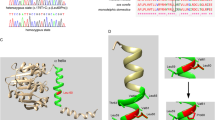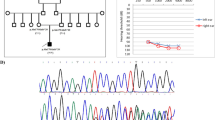Abstract
Pathogenic variants in the GJB2 gene are the most common reason for nonsyndromic sensorineural hearing loss. In this study, we examined Georgian patients with sensorineural hearing loss. We establish the ratio of GJB2-related deafness among patients with impaired hearing. The mutation spectrum of the GJB2 gene in Georgia is represented by the following pathogenic variants: c.35delG, c.358_360delGAG, c.‒23+1G>A, and c.551G>C. The estimated GJB2-related hearing loss carrier frequency is 2.6%. The following variants, which are common in Russian patients, were not detected in Georgian patients: STRC (c.2171_2174delTTTG), USH2A (c.11864G>A), SLC26A4 (c.1001G>T) and c.107A>C (p.His36Pro), CLIC5 (c.1121G>A). Molecular genetic diagnosis was established for 30.8% of patients.



Similar content being viewed by others

REFERENCES
Kenneson, A., Van Naarden Braun, K., and Boyle, C., GJB2 (connexin 26) variants and nonsyndromic sensorineural hearing loss: a HuGE review, Genet. Med., 2002, vol. 4, no. 4, pp. 258—274. https://doi.org/10.1097/00125817-200207000-00004
Kral, A. and O’Donoghue, G.M., Profound deafness in childhood, N. Engl. J. Med., 2010, vol. 363, no. 15, pp. 1438—1450. https://doi.org/10.1056/NEJMra0911225
ACMG, Genetics evaluation guidelines for the etiologic diagnosis of congenital hearing loss: genetic evaluation of congenital hearing loss expert panel: ACMG statement, Genet. Med., 2002, vol. 4, pp. 162—171.
Hone, S.W. and Smith, R.J., Medical evaluation of pediatric hearing loss: laboratory, radiographic, and genetic testing, Otolaryngol. Clin. North Am., 2002, vol. 35, pp. 751—764.
Bolz, H., Hereditary hearing loss and its syndromes third edition, Eur. J. Hum. Genet., 2016, vol. 24, p. 1650. https://doi.org/10.1038/ejhg.2016.67.
Kumar, N.M. and Gilula, N.B., The gap junction communication channel, Cell, 1996, vol. 84, no. 3, pp. 381—388. https://doi.org/10.1016/s0092-8674(00)81282-9
Söhl, G. and Willecke, K., Gap junctions and the connexin protein family, Cardiovasc. Res., 2004, vol. 62, no. 2, pp. 228—232. https://doi.org/10.1016/j.cardiores.2003.11.013
Lee, S.W., Tomasetto, C., Paul, D., et al., Transcriptional downregulation of gap-junction proteins blocks junctional communication in human mammary tumor cell lines, J. Cell Biol., 1992, vol. 118, pp. 1213—1221.
Green, G.E., Scott, D.A., McDonald, J.M., et al., Carrier rates in the midwestern United States for GJB2 mutation causing inherited deafness, JAMA, 1999, vol. 28, pp. 2211—2216.
Sobe, T., Vreugde, S., Shahin, H., et al., The prevalence and expression of inherited connexin 26 mutations associated with nonsyndromic hearing loss in the Israeli population, Hum. Genet., 2000, vol. 106, pp. 50—57.
Bliznetz, E.A., Galkina, V.A., Matyushchenko, G.N., et al., Changes in the connexin 26 gene (GJB2) in Russian patients with hearing loss: results of long-term molecular diagnostics of hereditary nonsyndromic hearing loss, Russ. J. Genet., 2012, vol. 48, no. 1, pp. 101—112. https://doi.org/10.1134/S1022795412010036
Bliznetz, E.A., Martsul, D.N., Khorov, O.G., et al., Spectrum of the GJB2 mutations in Belarussian patients with hearing loss: findings of pilot genetic screening of hearing impairment in newborns, Russ. J. Genet., 2014, vol. 50, no. 2, pp. 191—197. https://doi.org/10.1134/S1022795414020033
Dzhemileva, L.U., Barashkov, N.A., Posukh, O.L., et al., Analysis of heterozygous carriage of 35delG, 235delC, and 167delT mutations in GJB2 gene among populations of Eurasia, Med. Genet., 2009, vol. 8, no. 8, pp. 20—28.
Morell, R.J., Kim, H.J., Hood, L.J., et al., Mutations in the connexin 26 gene (GJB2) among Ashkenazi Jews with nonsyndromic recessive deafness, N. Engl. J. Med., 1998, vol. 339, pp. 1500—1505.
Cryns, K., Orzan, E., Murgia, A., et al., A genotype—phenotype correlation for GJB2 (connexin 26) deafness, Med. Genet., 2004, vol. 41, pp. 147—154.
Chan, D.K. and Chang, K.W., GJB2-associated hearing loss: systematic review of worldwide prevalence, genotype, and auditory phenotype, Laryngoscope, 2014, vol. 124, no. 2, pp. E34—E53. https://doi.org/10.1002/lary.24332
Barashkov, N.A., Dzhemileva, L.U., Fedorova, S.A., et al., Connexin 26 gene (GJB2) mutations in patients with hereditary non-syndromic sensorineural loss of hearing in the Republic of Sakha (Yakutia), Vestn. Otolaringol., 2008, no. 5, pp. 23—29.
Bliznetz, E.A., Sarkisyan, T.F., Manukyan, T.A., et al., GJB2 caused hearing loss in Armenians, Med. Genet., 2012, vol. 11, no. 5 (119), pp. 23—28.
Bliznetz, E.A., Lalayants, M.R., Markova, T.G., et al., Update of the GJB2/DFNB1 mutation spectrum in Russia: a founder Ingush mutation del (GJB2-D13S175) is the most frequent among other large deletions, J. Hum. Genet., 2017, vol. 62, no. 8, pp. 789—795. https://doi.org/10.1038/jhg.2017.42
Liu, X.Z., Yuan, Y., Yan, D., et al., Digenic inheritance of non-syndromic deafness caused by mutations at the gap junction proteins Cx26 and Cx31, Hum. Genet., 2009, vol. 125, no. 1, pp. 53—62. https://doi.org/10.1007/s00439-008-0602-9
Yu, X., Lin, Y., Xu, J., et al., Molecular epidemiology of Chinese Han deaf patients with bi-allelic and mono-allelic GJB2 mutations, Orphanet. J. Rare Dis., 2020, vol. 28, no. 15, no. 1, p. 29. https://doi.org/10.1186/s13023-020-1311-2
Baux, D., Vaché, C., Blanchet, C., et al., Combined genetic approaches yield a 48% diagnostic rate in a large cohort of French hearing-impaired patients, Sci. Rep., 2017, vol. 1, no. 7(1), p. 16783. https://doi.org/10.1038/s41598-017-16846-9
Najmabadi, H., Nishimura, C., Kahrizi, K., et al., GJB2 mutations: passage through Iran, Am. J. Med. Genet., 2005, vol. 133A, no. 2, pp. 132—137. https://doi.org/10.1002/ajmg.a.30576
Murgia, A., Orzan, E., Polli, R., et al., Cx26 deafness: mutation analysis and clinical variability, J. Med. Genet., 1999, vol. 36, no. 11, pp. 829—832.
Mahdieh, N., Nishimura, C., Ali-Madadi, K., et al., The frequency of GJB2 mutations and the Delta (GJB6-D13S1830) deletion as a cause of autosomal recessive non-syndromic deafness in the Kurdish population, Clin. Genet., 2004, vol. 65, no. 6, pp. 506—508.https://doi.org/10.1111/j.1399-0004.2004.00262.x
Yilmaz, A., Menevse, S., Bayazit, Y., et al., Two novel missense mutations in the connexin 26 gene in Turkish patients with nonsyndromic hearing loss, Biochem. Genet., 2010, vol. 48, nos. 3—4, pp. 248—256. https://doi.org/10.1007/s10528-009-9314-7
Snoeckx, R.L., Huygen, P.L., Feldmann, D., et al., GJB2 mutations and degree of hearing loss: a multicenter study, Am. J. Hum. Genet., 2005, vol. 77, no. 6, pp. 945—957. https://doi.org/10.1086/497996
Denoyelle, F., Marlin, S., Weil, D., et al., Clinical features of the prevalent form of childhood deafness, DFNB1, due to a connexin-26 gene defect: implications for genetic counselling, Lancet, 1999, vol. 17, no. 353, no. 9161, pp. 1298—1303. https://doi.org/10.1016/S0140-6736(98)11071-1
Bonyadi, M., Fotouhi, N., and Esmaeili, M., Prevalence of IVS1+1G>A mutation among Iranian Azeri Turkish patients with autosomal recessive non-syndromic hearing loss (ARNSHL), Int. J. Pediatr. Otorhinolaryngol., 2011, vol. 75, no. 12, pp. 1612—1615. https://doi.org/10.1016/j.ijporl.2011.09.024
Seeman, P. and Sakmaryová, I., High prevalence of the IVS1+1G to A/GJB2 mutation among Czech hearing impaired patients with monoallelic mutation in the coding region of GJB2, Clin. Genet., 2006, vol. 69, no. 5, pp. 410—413. https://doi.org/10.1111/j.1399-0004.2006.00602.x
Barashkov, N.A., Dzhemileva, L.U., Fedorova, S.A., et al., Autosomal recessive deafness 1A (DFNB1A) in Yakut population isolate in Eastern Siberia: extensive accumulation of the splice site mutation IVS1+1G>A in GJB2 gene as a result of founder effect, J. Hum. Genet., 2011, vol. 56, no. 9, pp. 631—619. https://doi.org/10.1038/jhg.2011.72
Denoyelle, F., Weil, D., Maw, M.A., et al., Prelingual deafness: high prevalence of a 30delG mutation in the connexin 26 gene, Hum. Mol. Genet., 1997, vol. 6, no. 12, pp. 2173—2177. https://doi.org/10.1093/hmg/6.12.2173
Pfenniger, A., Wohlwend, A., and Kwak, B.R., Mutations in connexin genes and disease, Eur. J. Clin. Invest., 2011, vol. 41, no. 1, pp. 103—116. https://doi.org/10.1111/j.1365-2362.2010.02378.x
Marková, S.P., Brožková, D.Š., Laššuthová, P., et al., STRC gene mutations, mainly large deletions, are a very important cause of early-onset hereditary hearing loss in the Czech population, Genet. Test. Mol. Biomarkers, 2018, vol. 22, no. 2, pp. 127—134. https://doi.org/10.1089/gtmb.2017.0155
https://hereditaryhearingloss.org/.
Funding
This work was carried out within the framework of the state task of the Ministry of Education and Science of Russia.
Author information
Authors and Affiliations
Corresponding author
Ethics declarations
Conflict of interest. The authors declare that they have no conflict of interest.
Statement of compliance with standards of research involving humans as subjects. All procedures performed in a study involving people comply with the ethical standards of the institutional and/or national committee for research ethics and the 1964 Helsinki Declaration and its subsequent changes or comparable ethical standards.
Informed voluntary consent was obtained from each of the participants.
Rights and permissions
About this article
Cite this article
Stepanova, A.A., Ismagilova, O.R., Galeeva, N.M. et al. Molecular Genetic Study of the Causes of Nonsyndromic Sensorineural Hearing Loss in Patients from Georgia. Russ J Genet 58, 585–592 (2022). https://doi.org/10.1134/S1022795422050106
Received:
Revised:
Accepted:
Published:
Issue Date:
DOI: https://doi.org/10.1134/S1022795422050106



